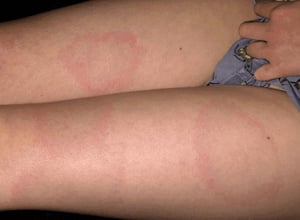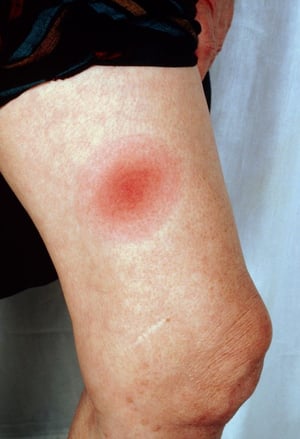|
Lyme disease has 3 stages: Early localized Early disseminated Late The early and late stages are usually separated by an asymptomatic interval. Manifestations of Erythema Migrans
Erythema Migrans Erythema migrans is the characteristic physical finding of early Lyme disease. It begins as a red macule at the site of the Ixodes tick bite. Classically, the macule expands with central clearing, as in this image, but, in many patients, no central clearing occurs. Some patients have central erythema surrounded by a pale ring, and a few develop vesicular or ulcerated centers.
Image courtesy of Thomas Habif, MD.
Variant in Erythema Migrans Erythema migrans may manifest as a rash with central erythema surrounded by a pale ring.
LARRY MULVEHILL/SCIENCE PHOTO LIBRARY
Erythema Migrans in Lyme Disease (Bull's Eye Rash) Erythema migrans can resemble a bull's eye, with central erythema surrounded by a pale ring and outer erythematous halo.
CDC/SCIENCE PHOTO LIBRARY
Erythema Migrans Erythema migrans is the characteristic physical finding of early Lyme disease. It begins as a red macule at the site of the Ixodes tick bite. Classically, the macule expands with central clearing, as in this image, but, in many patients, no central clearing occurs. Some patients have central erythema surrounded by a pale ring, and a few develop vesicular or ulcerated centers.
Image courtesy of Thomas Habif, MD.
Variant in Erythema Migrans Erythema migrans may manifest as a rash with central erythema surrounded by a pale ring.
LARRY MULVEHILL/SCIENCE PHOTO LIBRARY
Erythema Migrans in Lyme Disease (Bull's Eye Rash) Erythema migrans can resemble a bull's eye, with central erythema surrounded by a pale ring and outer erythematous halo.
CDC/SCIENCE PHOTO LIBRARY Early-localized stage Erythema migrans, the hallmark and best clinical indicator of Lyme disease, is the first sign of the disease. It occurs in at least 75% of patients, beginning as a red or dark macule or papule at the site of the tick bite, usually on the proximal portion of an extremity or the trunk (especially the thigh, buttock, or axilla), between 3 days and 32 days after a tick bite. Because tick nymphs are so small, most patients do not realize that they have been bitten. The area expands, often with clearing between the center and periphery resembling a bull’s eye, to a diameter ≤ 50 cm. Darkening erythema may develop in the center, which may be hot to the touch and indurated. Without therapy, erythema migrans typically fades within 3 to 4 weeks. Many patients with erythema migrans have a single lesion. Some patients develop multiple erythema migrans lesions, which are signs of early hematogenous dissemination (). Mucosal lesions do not occur. Apparent recurrences of erythema migrans lesions after treatment are caused by reinfection, rather than relapse, because the genotype identified in the new lesion differs from that of the original infecting organism. Early-disseminated stage Symptoms of early-disseminated disease begin days or weeks after the appearance of the primary lesion, when the bacteria spread through the body. Soon after onset, nearly half of untreated patients develop multiple, usually smaller annular secondary skin lesions without indurated centers. Cultures of biopsy samples of these secondary lesions have been positive, indicating dissemination of infection. Patients also develop a musculoskeletal, flu-like syndrome, consisting of malaise, fatigue, chills, fever, headache, stiff neck, myalgias, and arthralgias that may last for weeks. Because symptoms are often nonspecific, the diagnosis is frequently missed if erythema migrans is absent; a high index of suspicion is required. Frank arthritis is rare at this stage. Less common are backache, nausea and vomiting, sore throat, lymphadenopathy, and splenomegaly. Symptoms are characteristically intermittent and changing, but malaise and fatigue may linger for weeks. Resolved skin lesions may reappear faintly, sometimes before recurrent attacks of arthritis, in late-stage disease. Neurologic abnormalities develop in about 15% of patients within weeks to months of erythema migrans (generally before arthritis occurs), commonly last for months, and usually resolve completely. Most common are lymphocytic meningitis (cerebrospinal fluid [CSF] pleocytosis of about 100 cells/mcL) or meningoencephalitis, cranial neuritis (especially Bell palsy, which may be bilateral), and sensory or motor radiculoneuropathies, alone or in combination. Myocardial abnormalities occur in about 8% of patients within weeks of erythema migrans. They include fluctuating degrees of atrioventricular block (first-degree, Wenckebach, or third-degree) and, rarely, myopericarditis with chest pain, reduced ejection fractions, and cardiomegaly. Late-stage disease In untreated Lyme disease, the late stage begins months to years after initial infection. Arthritis develops in about 60% of patients within several months, occasionally up to 2 years, of disease onset (as defined by erythema migrans). Intermittent swelling and pain in a few large joints, especially the knees, typically recur for several years. Affected knees commonly are much more swollen than painful; they are often hot but rarely erythematous. Baker cysts may form and rupture. Malaise, fatigue, and low-grade fever may precede or accompany arthritis attacks. In about 10% of patients, knee involvement is chronic (unremittent for ≥ 6 months). Other late findings (occurring years after onset) include an antibiotic-sensitive skin lesion (acrodermatitis chronica atrophicans) and chronic central nervous system abnormalities, either polyneuropathy or a subtle encephalopathy with mood, memory, and sleep disorders. Some patients have symptoms such as fatigue, headache, joint and muscle aches, and cognitive problems after successful antibiotic treatment. These symptoms are collectively referred to as post-treatment Lyme disease syndrome (PTLDS) (). Although some patients with such subjective symptoms are assigned the diagnosis of chronic Lyme disease, there is no clear evidence that these patients have viable Borrelia remaining in their body. The cause of these continuing symptoms is unclear, and treatment with more antibiotics does not help. Symptoms and signs references 1. Nadelman RB, Hanincová K, Mukherjee P, et al: Differentiation of reinfection from relapse in recurrent Lyme disease. N Engl J Med 367(20):1883–1890, 2012. doi: 10.1056/NEJMoa1114362 2. Maksimyan S, Syed MS, Soti V: Post-Treatment Lyme Disease Syndrome: Need for Diagnosis and Treatment. Cureus 13(10):e18703, 2021. doi:10.7759/cureus.18703 (责任编辑:) |



